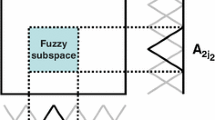Abstract
In this paper a specially designed structured-optimization procedure is used for learning the parameters of the Takagi–Sugeno (TS) type fuzzy models. It is well-known that the number of learning parameters increases exponentially with the number of model inputs. Therefore an appropriate learning scheme with preliminary structuring of the learning parameters into two groups: antecedent parameters and consequent parameters can be helpful for speeding-up the learning process. Two different optimization algorithms for tuning the antecedent and consequent parameters respectively are used in a sequence of repetitive loops (epochs). The stop criterion is defined as a number of repetitions of the loops or as a desired minimal error. Random walk algorithm with variable step size is used in this paper for tuning the antecedent parameters of the membership functions. For tuning the consequent parameters of the singletons, a specially proposed local learning algorithm is used. The problem of dimensionality reduction in fuzzy modeling is also considered in the paper from another viewpoint, namely as a hierarchical fuzzy model structure. It is accomplished by a decomposition of the complete fuzzy model into a feedforward hierarchical structure of sub-models called partial fuzzy models each one with two inputs and one output. Then the local models are learned separately in a preliminary specified and repetitive order. Such decomposition scheme has a potential for a significant reduction of the number of model parameters to be tuned thus reducing the total learning time. It has been experimentally shown that both concepts for dimensionality reduction in learning fuzzy models have benefits in learning speed and accuracy. A comparison with simultaneous optimization of all parameters of a single fuzzy model is also given. It shows that the proposed structured learning as well as the decomposition of the fuzzy model into a hierarchical fuzzy model structure lead to reducing the learning time and creating more accurate fuzzy models. Finally an application for learning a fuzzy controller of a two-link robot motion is shown and analysed.
Similar content being viewed by others
References
Hasegawa, Y. and Fukuda, T.: Self-scaling reinforcement learning algorithm for generating fuzzy controller, JSME Int. J., Ser. C 40(2) (1997), 316-322.
Horikawa, Sh., Furuhashi, T., Uchikawa, Y., and Tagawa, T.: A study on fuzzy modeling using fuzzy neural networks, in: Proc. of the Int. Fuzzy Engineering Symposium: IFES'95, Yokohama, 1995, pp. 562-573.
Jang, J. S. R.: ANFIS:Adaptive-Network-Based Fuzzy Inference System, IEEE Trans. Systems, Man Cybernet. 23(3) (1993), 65-685.
Lin, C.-T.: A neural fuzzy control system with structure and parameter learning, Fuzzy Sets and Systems 70 (1995), 183-212.
Pedrycz, W. and Reformat, M.: Rule-based modeling of nonlinear relationships, IEEE Trans. on Fuzzy Systems 5(2) (1997), 256-269.
Rovatti, R. and Guerrieri, R.: Fuzzy sets of rules for system identifications, IEEE Trans. on Fuzzy Systems 4(2) (1996), 89-102.
Shi, Y. and Mizumoto, M.: A tuning method of fuzzy rules by fuzzy singleton-type reasoning method. Part II, in: Proc. of the 5th Int. Conference IIZUKA'98, Oct. 16-20, 1998, Vol. 1, 1998, pp. 167-170.
Sun, C. T.: Rule-base structure identification in adaptive neural-based fuzzy inference system, IEEE Trans. Fuzzy Systems 2(1) (1994), 64-73.
Vachkov, G.: Algorithms for global and local learning of fuzzy models, in: Proc. of the 14th Fuzzy Symposium SOFT'98, Gifu, Japan, June, 1998, WF3-3, 1998, pp. 321-324.
Vachkov, G.: Fuzzy Control: Synthesis and Analysis, Chapter 3, in: Farinwata, Sh., Filev, D. and Langari, R. (eds), Adaptive and Learning Schemes for Fuzzy Modeling, JohnWiley & Sons, 2000, pp. 47-72.
Vachkov, G., Hasegawa, Y., and Fukuda, T.: Design of fuzzy controller for robot motion by local learning, in: Proc. of the 5th Int. Conference IIZUKA'98, Oct. 16-20, 1998, Vol. 1, 1998, pp. 446-449.
Yager, R. and Filev, D.: Generation of fuzzy rules by mountain clustering, Intelligent & Fuzzy Systems 2(3) (1994), 209-219.
Yamauchi, K. and Ishii, N.: Combination of fast and slow learning methods for fast adaptation and pruning of redundant cells, in: Proc. of the Fifth Int. Conf. on Neural Information Processing, ICONIP'98, Kitakyushu, Japan, Oct., 1999, 1998, pp. 757-760.
Yen, J., Wang, L., and Gillespie, C. W.: Improving the interpretability of TSK fuzzy models by combining global and local learning, IEEE Trans. on Fuzzy Systems 6(4) (1998), 530-537.
Ying, H.: General SISO Takagi-Sugeno fuzzy systems with linear rule consequent are universal approximators, IEEE Trans. on Fuzzy Systems 6(4) (1998), 582-587.
Author information
Authors and Affiliations
Rights and permissions
About this article
Cite this article
Vachkov, G., Fukuda, T. Structured Learning and Decomposition of Fuzzy Models for Robotic Control Applications. Journal of Intelligent and Robotic Systems 32, 1–21 (2001). https://doi.org/10.1023/A:1012025926521
Issue Date:
DOI: https://doi.org/10.1023/A:1012025926521




